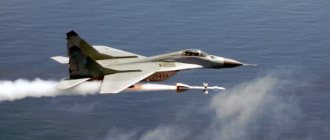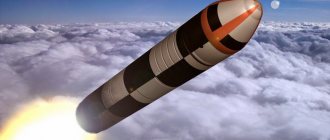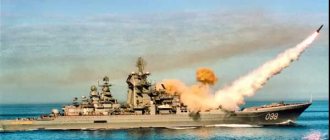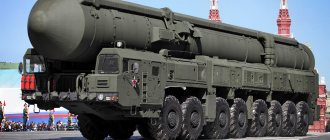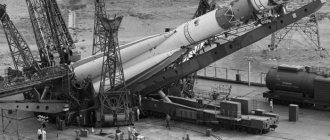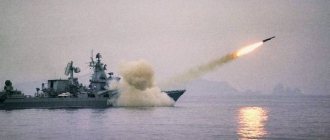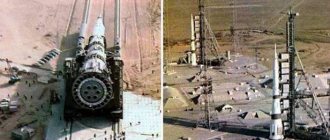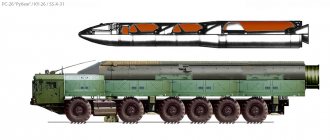Rice. 1. Diagram of a composite rocket with transverse division.
ROCKET (from Italian rocchetta - small spindle), an aircraft moving under the action of reactive force (thrust) that occurs when the mass of burning rocket fuel (working fluid) is thrown away, which is part of its own. masses R. In military. terminology the word "R." denotes a class, as a rule, of unmanned aircraft used to destroy remote objects (delivery of a combat charge, conventional or nuclear, to a target) and using the principle of jet propulsion for flight (see also Missile weapons, Nuclear missile weapons). R.'s flight does not require the presence of an atmosphere, which allows it to be used as a basis. technical means to achieve cosmic space and one of the most effective means of delivering warheads to the military. actions. Depending on the type of fuel used in the rocket engine (see Rocket Fuels), most rocket engines are divided into rocket engines with liquid-fuel rocket engines (LPRE) and solid-fuel rocket engines. When flying in the atmosphere, air-breathing engines are also used. In the future, it is possible to create rockets using a nuclear rocket engine.
Rocket engines
Engines are the most important component of a launch vehicle. They create the traction force that propels the rocket into space. But when it comes to rocket engines, you shouldn’t remember those that are under the hood of a car or, for example, turning the rotor blades of a helicopter. Rocket engines are completely different.
The operation of rocket engines is based on Newton's third law. The historical formulation of this law says that for any action there is always an equal and opposite reaction, in other words, a reaction. That's why these engines are called jet engines.
During operation, a jet rocket engine ejects a substance (the so-called working fluid) in one direction, while it itself moves in the opposite direction. To understand how this happens, you don't have to fly a rocket yourself. The closest, “earthly” example is the recoil that occurs when firing a firearm. The working fluid here is the bullet and powder gases escaping from the barrel. Another example is an inflated and released balloon. If you don't tie it down, it will fly until the air comes out. The air here is the very working fluid. Simply put, the working fluid in a rocket engine is the combustion products of rocket fuel.
Model of the RD-180 rocket engine /© Wikipedia.
Electronics
As an on-board computer, I use my own circuit, which is based on an Arduino Nano.
Flight computer diagram
Components:
- Barometer BMP180
- Gyroscope-accelerometer MPU6050
- Squeaker
- microSD module
- Relay\MOSFET for activating the mortar fuse
- 2 pcs. 18650 batteries
- LM7805 voltage step down for controller
- Mini toggle switch to turn on the computer
- JST-2P connector for connecting to a mortar igniter
When the computer starts, all sensors and modules are initialized, the current altitude is recorded, and a sound signal is given to enter the standby start mode. The start moment is considered to be the case when the altitude changes by a threshold value (for example, 5 meters).
if (delta_altitude > max_delta) { // start }
At the moment of start, the time is recorded (the time is recorded), then data from the sensors begins to be recorded on the card. During the flight, the apogee is monitored - the current altitude is recorded if it is less than the previous one. If the current height drops to the threshold value, then we light the expelling charge.
if (altitude > max_altitude) { max_altitude = altitude; } // Check for apogee, do not allow to release chute while too close to ground or while engine still working if ((max_altitude - altitude) > max_delta and ignited == false and ((millis() - start_time) > apogee_delay)) { ignite(); }
The moment of landing is not calculated, we simply assume that in two minutes the rocket should land on the ground. After two minutes, recording on the card stops and sound signals begin to sound to facilitate the search for the missile.
The full sketch can be found here.
Fuel
Rocket engine fuel is usually two-component and includes a fuel and an oxidizer. The Proton launch vehicle uses heptyl (unsymmetrical dimethylhydrazaine) as fuel and nitrogen tetroxide as an oxidizer. Both components are extremely toxic, but this is a “memory” of the missile’s original combat purpose. The UR-500 intercontinental ballistic missile, the progenitor of the Proton, having a military purpose, had to be in a combat-ready state for a long time before launch. And other types of fuel did not allow for long-term storage. The Soyuz-FG and Soyuz-2 rockets use kerosene and liquid oxygen as fuel. The same fuel components are used in the Angara family of launch vehicles, Falcon 9 and Elon Musk's promising Falcon Heavy. The fuel pair of the Japanese H-IIB launch vehicle (H-to-bee) is liquid hydrogen (fuel) and liquid oxygen (oxidizer). As in the rocket of the private aerospace company Blue Origin, used to launch the New Shepard suborbital ship. But these are all liquid rocket engines. Solid propellant rocket engines are also used, but, as a rule, in the solid propellant stages of multistage rockets, such as the starting accelerator of the Ariane 5 launch vehicle, the second stage of the Antares launch vehicle, and the side boosters of the Space Shuttle.
Historical reference
Most historians date the origins of rockets to the times of China. Han Dynasty (206 BC - 220 AD), to the discovery of gunpowder and its use for fireworks and entertainment. In the 13th century together with Mong. The conquerors brought R. to Europe, and in 1248 R. Bacon published a work on their use. The single term "rocket" appeared in Europe in the 15th and 16th centuries. In India at the end. 18th century rocket weapons were used in battles with the British. troops. In the beginning. 19th century British The army adopted combat missiles, which were developed by W. Congreve. In Russia, the development of R. is associated with the names of A. D. Zasyadko and K. I. Konstantinov.
Since the 1820s The first research centers in the field of rocket science are being created - Woolwich Arsenal (UK), Pyrotechnic. school in Metz (France), St. Petersburg. rocket establishment (Russia), etc. Scientific. foundations of the mechanics of bodies of variable mass in the 1890s. were founded by I.V. Meshchersky. The first theorist of interplanetary flights was K. E. Tsiolkovsky. In 1926, R. Goddard carried out the world's first rocket launch with a liquid-propellant rocket engine. Mn. questions of cosmic theory. flight and rocket science found a new solution in the works of Yu. V. Kondratyuk, G. Oberth, F. A. Tsander, N. I. Tikhomirov and other scientists. From the end 1920s - early 1930s The state started developing rocket engines with liquid propellant engines. organizations. In the USSR, research work was carried out by the Jet Propulsion Study Group (Moscow) and Gasodynamic. laboratory (Leningrad). In 1933, on their basis, the Jet Institute was created, and in the same year, the creation of a fundamentally new weapon, begun in 1929, was completed - shells for the Katyusha rocket mortar. In 1931 the first growths were tested. Liquid rocket engine - ORM (experimental rocket motor) and ORM-1, created by V. P. Glushko in Gasdynamics. laboratories. In the beginning. 1940s in Germany, single-stage ballistics were developed and used in combat conditions in 1944. R. A-4 (V-2, chief designer - W. von Braun) and winged R. (projectile aircraft) Fi-103 (V-1), in the USSR - R-1 and the first ballistic. R. with a detachable warhead R-2 (chief designer - S. P. Korolev).
In 1958, the United States adopted the first Atlas ICBM. In the 2nd half. 1950s There was a transition from single-stage R. to multi-stage. In 1957 in the USSR under the leadership of. Korolev created and in 1960 adopted the two-stage ICBM R-7, which on October 4, 1957 was used to launch the world's first satellite. Made according to a scheme with longitudinal division of steps (according to the so-called batch scheme); the first stage consisted of four side rocket blocks located symmetrically around the central one (second stage). R. has become the most important means for space research. space (see Cosmonautics).
steps
The payload launched into space is only a small fraction of the rocket's mass. Launch vehicles primarily “transport” themselves, that is, their own structure: fuel tanks and engines, as well as the fuel needed to operate them. Fuel tanks and rocket engines are located in different stages of the rocket and, as soon as they exhaust their fuel, they become unnecessary. In order not to carry extra load, they are separated. In addition to full-fledged stages, external fuel tanks that are not equipped with their own engines are also used. During the flight they are also reset.
The first stage of the Proton-M launch vehicle /© Federal State Unitary Enterprise "GKNPTs named after M.V. Khrunichev"
There are two classical schemes for constructing multi-stage rockets: with transverse and longitudinal separation of stages. In the first case, the stages are placed one above the other and are turned on only after the separation of the previous, lower, stage. In the second case, several identical rocket stages are located around the body of the second stage, which are turned on and dropped simultaneously. In this case, the second stage engine can also operate during start-up. But a combined longitudinal-transverse scheme is also widely used.
Missile layout options /© Wikipedia
The Rokot light-class launch vehicle, launched in February of this year from the cosmodrome in Plesetsk, is a three-stage rocket with a transverse separation of stages. But the Soyuz-2 launch vehicle, launched from the new Vostochny cosmodrome in April of this year, is a three-stage one with a longitudinal-transverse division.
An interesting design for a two-stage longitudinally separated rocket is the Space Shuttle system. This is where the difference between the American shuttles and the Buran lies. The first stage of the Space Shuttle system is the side solid fuel boosters, the second is the shuttle itself (orbiter) with a detachable external fuel tank, which is shaped like a rocket. During liftoff, both the shuttle and booster engines fire. In the Energia-Buran system, the two-stage super-heavy launch vehicle Energia was an independent element and, in addition to launching the Buran MTSC into space, could be used for other purposes, for example, to support automatic and manned expeditions to the Moon and Mars.
Flight and results
Characteristics of the assembled rocket:
- Length: 1300 millimeters
- Diameter: 50 millimeters
- Case weight (with all components): 1000 grams
- Electronics weight: 180 grams
- Engine weight: 440 grams
- Total weight: 1620 grams
- Engine: DKR-30-9-280-PE(S)
- Class: H115, maximum thrust - 180 N*s
- Estimated (maximum) apogee: 530 meters
- Time to apogee: 11.5 seconds
The rocket took off.
The flight was generally successful, the rocket reached its apogee at 400 meters.
The rocket landed with a parachute 200 meters from the launch site.
The parachute has opened!
It is curious that the data from the accelerometer shows spikes corresponding to the operation of the rescue system (mortar).
Raw data from logger
Acceleration block
It may seem that as soon as the rocket goes into space, the goal is achieved. But it is not always the case. The target orbit of a spacecraft or payload can be much higher than the line from which space begins. For example, the geostationary orbit, which hosts telecommunications satellites, is located at an altitude of 35,786 km above sea level. This is why we need an upper stage, which, in fact, is another stage of the rocket. Space begins already at an altitude of 100 km, where weightlessness begins, which is a serious problem for conventional rocket engines.
One of the main “workhorses” of Russian cosmonautics, the Proton launch vehicle paired with the Breeze-M upper stage ensures the launch of payloads weighing up to 3.3 tons into geostationary orbit. But initially the launch is carried out into a low reference orbit (200 km ). Although the upper stage is called one of the stages of the ship, it differs from the usual stage in its engines.
“Proton-M” launch vehicle with “Briz-M” upper stage in assembly /© Federal State Unitary Enterprise “GKNPTs named after M.V. Khrunichev”
To move a spacecraft or vehicle into a target orbit or direct it onto an outbound or interplanetary trajectory, the upper stage must be able to perform one or more maneuvers that change the flight speed. And for this you need to turn on the engine every time. Moreover, during periods between maneuvers, the engine is turned off. Thus, the upper stage engine is capable of being switched on and off repeatedly, unlike the engines of other rocket stages. The exceptions are the reusable Falcon 9 and New Shepard, whose first stage engines are used for braking when landing on Earth.
Modernization
The rocket is extremely modernized; a fundamentally different digital control system has been created here, developed on a new domestic element base, with a high-speed on-board digital computer with a much larger amount of RAM. The digital control system provides the rocket with high-precision launch of payloads.
In addition, engines have been installed on which the injector heads of the first and second stages have been improved. A different telemetry system is in effect. Thus, the accuracy of the missile launch, its stability and, of course, controllability have increased. The mass of the space rocket did not increase, but the useful payload increased by three hundred kilograms.
Payload
Rockets exist to launch something into space. In particular, spaceships and spacecraft. In the domestic cosmonautics, these are the Progress transport cargo ships and the Soyuz manned spacecraft sent to the ISS. Of the spacecraft this year, the American Intelsat DLA2 spacecraft and the French Eutelsat 9B spacecraft, the domestic navigation spacecraft Glonass-M No. 53 and, of course, the ExoMars-2016 spacecraft, designed to search for methane in atmosphere of Mars.
The rockets have different capabilities for launching payloads. The payload weight of the light-class Rokot launch vehicle, intended for launching spacecraft into low Earth orbits (200 km), is 1.95 tons. The Proton-M launch vehicle belongs to the heavy class. It launches 22.4 tons into low orbit, 6.15 tons into geostationary orbit, and 3.3 tons into geostationary orbit. Soyuz-2, depending on the modification and the cosmodrome, is capable of delivering from 7.5 to 8.7 t, to geostationary transfer orbit - from 2.8 to 3 t and to geostationary - from 1.3 to 1.5 t. The rocket is designed for launches from all Roscosmos sites: Vostochny, Plesetsk, Baikonur and Kuru, used as part of joint Russian-European project. Used to launch transport and manned spacecraft to the ISS, the Soyuz-FG LV has a payload mass from 7.2 tons (with the Soyuz manned spacecraft) to 7.4 tons (with the Progress cargo spacecraft). Currently, this is the only rocket used to transport cosmonauts and astronauts to the ISS.
The payload is usually located at the very top of the rocket. In order to overcome aerodynamic drag, a spacecraft or ship is placed inside the rocket's head fairing, which is discarded after passing through the dense layers of the atmosphere.
The words of Yuri Gagarin, which went down in history: “I see the Earth... What beauty!” were told to them precisely after the release of the head fairing of the Vostok launch vehicle.
Installation of the head fairing of the Proton-M launch vehicle, payload of the Express-AT1 and Express-AT2 spacecraft /© Roscosmos
Something about a space rocket
Since the parameters and technical characteristics of all rockets differ from each other, let’s consider a new generation launch vehicle, for example, Soyuz-2.1A. It is a three-stage medium-class rocket, a modified version of the Soyuz-U, which has been in very successful operation since 1973.
This launch vehicle is designed to launch spacecraft. The latter may have military, economic and social purposes. This rocket can launch them into different types of orbits - geostationary, geostationary, sun-synchronous, highly elliptical, medium, low.
